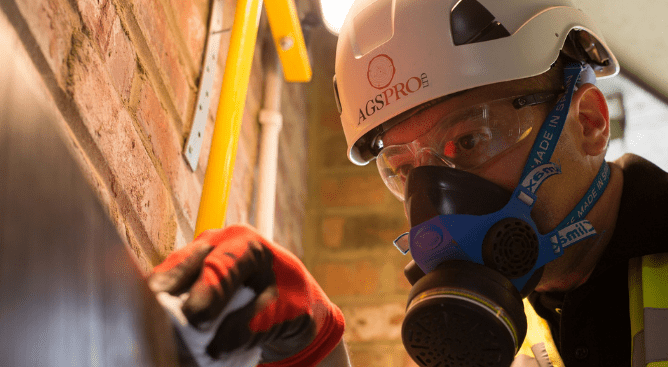Updated 5 July 2022.
Always remember - any building built before 2000, has the potential to have Asbestos Containing Materials (ACMs) present. If your building was built after 2000, you don’t need to read any further...but it wouldn’t hurt.
The Health and Safety Executive also remind us on its website that brownfield sites may be contaminated with asbestos if previously developed - often for industrial and commercial purposes. Old equipment, such as ovens, brakes, soundproofing, insulating mats, fire blankets, oven gloves, ironing surfaces may also contain asbestos.
If you are in any doubt and need advice about asbestos, contact Asbestos Limited, specialists in asbestos management, based in Kent.
This is the first of a 2 part blog to offer guidance to anyone who is responsible for producing an Asbestos Register. The next instalment is here 'When asbestos management goes wrong'.
Who and What needs an Asbestos Register?
The ‘Who’:
If you are responsible for the maintenance or repair of premises (or equipment for that matter), you are the duty holder, so you are the ‘Who’.
The ‘What’:
Applies to all buildings (domestic and commercial) if all or part of the building needs upgrading, refurbishment or demolition.
Even if no work is required, commercial buildings must still be managed, This also applies to the common parts of domestic buildings, for example: stairwells, lofts, boiler rooms, lift shafts, out-houses and any equipment that may contain asbestos.
The HSE’s website provides a useful table of domestic/non-domestic premises which will help you identify where this duty applies.
Our best rule of the thumb for this is if you haven’t gone through a private front door, the site needs an Asbestos Register. If you're in any doubt, contact us.
Full details regarding the Duty to Manage are in regulation 4 of the Control of Asbestos Regulations 2012 and a brief 4-step resource to achieve compliance can be found on our website: The Process of Asbestos Management page.
An example of when a pre-refurb survey is required
Imagine you are having a wall removed between 2 rooms. You need to establish whether there are any ACMs present BEFORE you knock the wall down and contaminate the building and its occupants.
Having an Asbestos Pre-refurb survey carried out on the area that is going to be disturbed would establish this. The survey can be as simple as just inspecting the wall. However, if the work proposed is slightly more invasive (let’s say the removal of the wall will open up a void area, such as a loft) then this will also need to be included in the survey.
With the benefit of the survey, you can decide whether to continue with your plans or establish a work around that won’t disturb any ACMs; potentially saving you money on something that could have opened a can of worms.
Of course it is also a legal requirement, not to mention your Duty of Care, but this should not be the reason you survey the site. The health of the premise’s occupants and that of the builders/construction workers is the top priority.
If you really want to know why you shouldn’t be exposed to asbestos, please check out Ray and Mave’s blog. Mave is an amazing woman and in spite of a mesothelioma diagnosis, usually being a maximum of 2 years fighting, she is making ground-breaking history.
And financially, why is an asbestos survey a good idea?
So we’ve covered the legal/moral and health reasons. This is the financial reason for giving the Asbestos Survey the time and attention it needs.
If you plan your work appropriately, it’s like having the benefit of hindsight. You establish what work is required, risk assess everything (asbestos, gas, electrics, structure and so on) to make sure that it’s OK to proceed. Efficient, cost effective planning is a bit like this Heineken advert. The resolution from 1998 isn’t great, but you get the idea. Hopefully, 22 years later, these site guys are now in the office planning the works before they start 😉
We had an enquiry some years ago, from a client who was having work carried out to a rather large commercial building. Their enquiry was for an Asbestos Pre-refurb Survey of the premises and the quotes all ran into quite a few thousand pounds. Fortunately, we chatted through what they were actually trying to achieve and established that the client was adding an extension that would, in reality, only disturb the back wall. Suddenly we were able to tailor their specification to just what needed to be risk assessed in the event of a potential disturbance. The quote changed from 5 days on site to 1 day and the quote value changed to reflect this.
What is the Duty to Manage?
The duty to manage asbestos is contained in Regulation 4 of the Control of Asbestos Regulations 2012. It requires the person who has the duty (i.e., the ‘duty holder’) to:
- Take reasonable steps to find out if there are materials containing asbestos in non-domestic premises and if so, its amount, where it is and what condition it is in.
- Presume materials do contain asbestos unless there is strong evidence that they do not.
- Make and keep up-to-date, a record of the location and condition of the asbestos containing materials - or materials which are presumed to contain asbestos.
- Assess the risk of anyone being exposed to fibres from the materials identified.
- Prepare a plan that sets out, in detail how the risks from these materials will be managed.
- Take the necessary steps to put the plan into action.
- Periodically review and monitor the plan and the arrangements to act on it, so that the plan remains relevant and up-to-date.
- Provide information on the location and condition of the materials to anyone who is liable to work on or disturb them.
There is also a requirement on others to cooperate, as far as is necessary, to allow the duty holder to comply with the above requirements.
Solutions to 1-8 above are:
- Have an Asbestos Survey carried out. This could be an Asbestos Management Survey and a Pre-refurb/Demo Survey.
- Any negative results in the survey are the strong evidence you need.
- Your original Asbestos Register (usually a table) should be created and included within your Management Survey.
- This is established by using the priority score algorithm in HSG 227.
- Your management plan collates all of the asbestos related information you have and establishes a plan.
- Appoint your team of responsible persons and organisations and detail them in your management plan.
- Ongoing management can be carried out in-house, although it is advisable to appoint an independent re-inspection company to attend (possibly only annually) to confirm your management plan is current and accurate.
- Permit to work system.
Do you help or advice?
This blog has covered in detail the circumstances under which an Asbestos Register is needed - whether due to a refurb/renovation or simply due to the ongoing management of ACMs to comply with Regulation 4 of the Asbestos Regulations.
If you’re interested in further information get in touch via our Enquiry form or call us on 01634 232221.
We cover this subject in a short video: 'What is an Asbestos survey?'
Our YouTube channel covers more FAQs, so please visit the channel for more information.
Our next blog 'When asbestos management goes wrong' looks at some particular scenarios around the regulations in place. We'll also alert you to the potential pitfalls a premises owner can find themselves in, if they don’t get the process correct from the start.




